The Microsoft Surface Studio Review
by Brett Howse on January 20, 2017 8:00 AM EST- Posted in
- Desktop
- Microsoft
- Surface
- Surface Studio
System Performance
As is typical with an all-in-one PC, the Surface Studio uses mobile parts to ensure things don’t get too toasty. The base model ships with a Core i5-6440HQ, which is a quad-core processor running at 2.6-3.5 GHz. There is 6 MB of cache and no hyperthreading, and it has a 45-Watt TDP. The CPU is likely fine for most tasks, but the base Surface Studio comes with just 8 GB of DDR4 memory, which would hardly be called adequate for an almost $3000 computer. Graphics to run the 13.5 million pixel display come courtesy of the NVIDIA GeForce GTX 965M, launched at CES in 2015.
The jump up to the mid-level model offers a lot more computer, but comes at a cost of an additional $500. The CPU is upgraded to the Core i7-6820HQ, which is a quad-core with hyperthreading, and a 2.7-3.6 GHz frequency, along with 8 MB of cache. The big upgrade is the RAM, which doubles to a more respectable 16 GB, and while the GPU is the same, and the hard drive capacity is the same, the mid-level model doubles the SSD cache from a 64 GB SATA SSD to a 128 GB PCIe SSD. While the CPU is going to offer more performance, especially in heavily-threaded workloads, the increased RAM and SSD cache are likely to do more for the overall performance than anything, and the mid-level is really where the Surface Studio should have started.
Our review unit is the top level model, with the same Core i7-6820HQ CPU as the mid-level model, but with double the RAM again, which means 32 GB of DDR4. The hybrid hard drive capacity is also doubled, to 2 TB, with the same 128 GB of PCIe SSD cache. The biggest upgrade on the top model is the graphics, which jumps from the GeForce GTX 965M all the way to the GeForce GTX 980M. This was the top mobile graphics card available until earlier this year when the GeForce GTX 10 series launched, and it offers quite a bit more performance. The GTX 965M was a solid performer for low-end gaming, but the GTX 980M offers more of everything, with double the video memory to 4 GB, more memory bandwidth, more CUDA cores, and far more performance.
Much has been made of the fact that the Surface Studio shipped with “old technology” in a Skylake CPU, when Kaby Lake CPUs were available, and especially the Maxwell based graphics, when Pascal was launched. The CPU argument was never true though, with quad-core Kaby Lake only available since the beginning of 2017, and Kaby Lake offers no IPC increases over Skylake, although they can run at a higher frequency for the same power consumption. The GPU argument is sound though, and the Pascal based GPUs would offer greater performance for less power consumption, and therefore less heat generated. The new GPUs are not pin-compatible though, meaning Microsoft would have had to redesign the board completely, as well as possibly addressed the different TDPs of the mobile chips, but this would have been engineering time well spent.
| NVIDIA Mobile Maxwell GPUs | |||||
| GeForce GTX 965M | GeForce GTX 980M | ||||
| CUDA Cores | 1024 | 1536 | |||
| Core Clock | 944 + Boost | 1038 + Boost | |||
| Memory | 2 GB GDDR5 128-bit | 4 GB GDDR5 256-bit | |||
| Memory Clock | 2500 MHz | 2500 MHz | |||
| Memory Bandwidth | 80 GB/s | 160 GB/s | |||
Ultimately, it would have been nice to see a GTX 1070 and GTX 1060 options, or even a GTX 1050 to replace the GTX 965M, although that GPU just launched for laptops at CES 2017. The performance increases alone would be significant, but there are also advantages such as full hardware decode for HEVC on the Pascal chips which would have been a nice feature. Clearly the timing did not work out, and Microsoft said they had to choose the components a year before launch. They likely didn’t want to risk choosing Pascal and then having supply issues, but at the end of the day they made a conservative decision.
So let’s see how the Surface Studio does perform, with the Skylake and Maxwell combination that is available. The Surface Studio was run through our standard suite of tests, and for comparisons it is put up against some of the more recent laptops we’ve tested.
PCMark
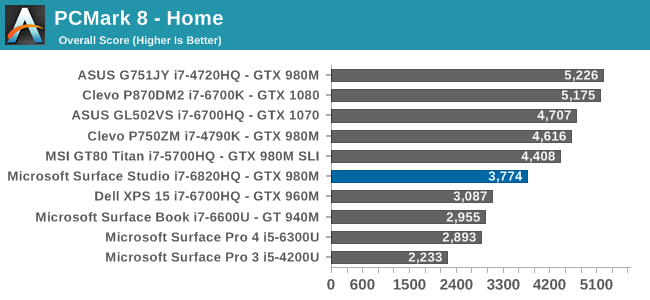

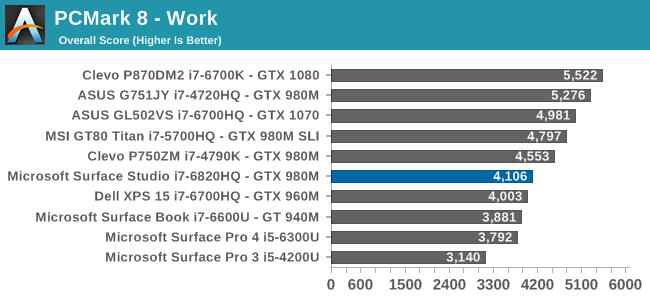
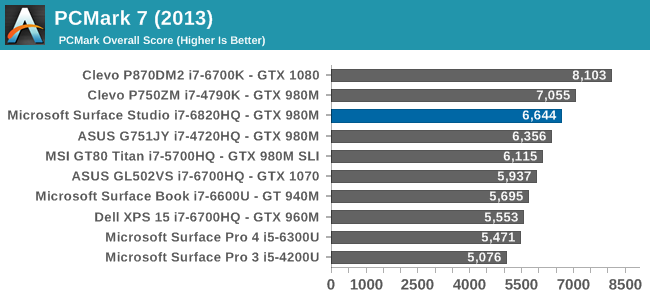
PCMark is a comprehensive set of tests, which uses real-world applications to test system responsiveness and performance. All aspects of the system are tested, including the storage, and even display resolution can have an affect. Here the Surface Studio is decidedly average, with decent scores in some tests, but less than amazing results in others. The hybrid storage and high display resolution likely didn’t help out the Surface Studio here.
Cinebench
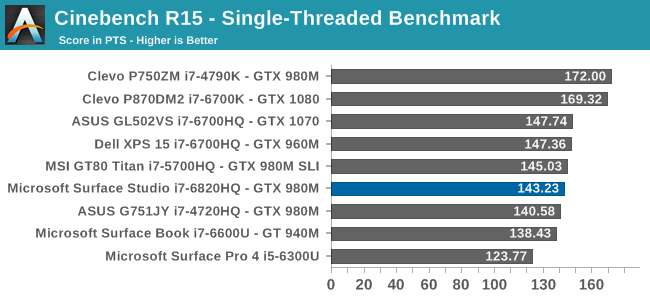
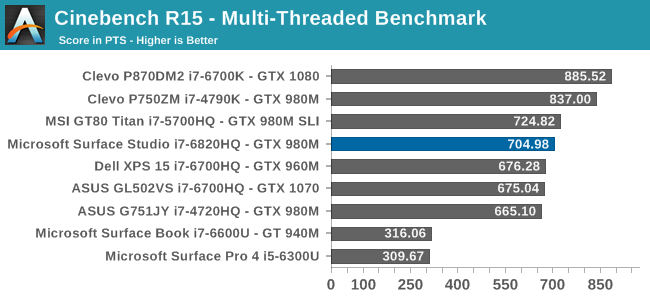
Cinebench is a purely CPU test, and despite the Surface Studio having a Core i7-6820HQ when most quad-core laptops are the i7-6700HQ, it still fell slightly below them on this test.
X264
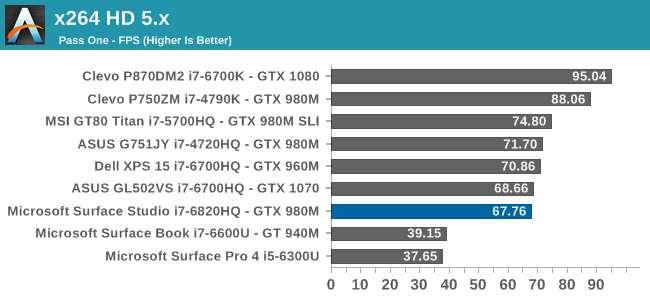
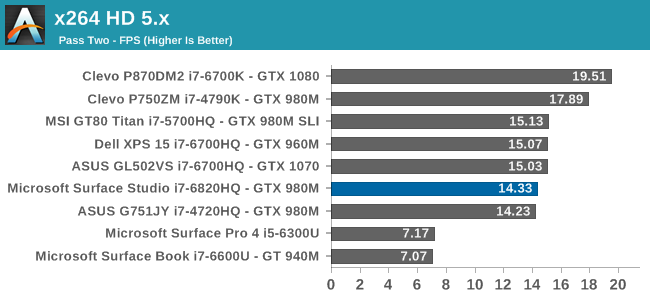
Much like Cinebench, this is a pure CPU test, but unlike Cinebench which renders an image, x264 encodes a video file. As with Cinebench, the Surface Studio falls a bit under the performance of the i7-6700HQ found in most notebooks.
Web Tests
Browsing the web is likely what most computers do, most of the time, but unlike the previous tests, web tests are always evolving over time as the underlying browsers are updated. For our tests, we use the latest version of Microsoft Edge.
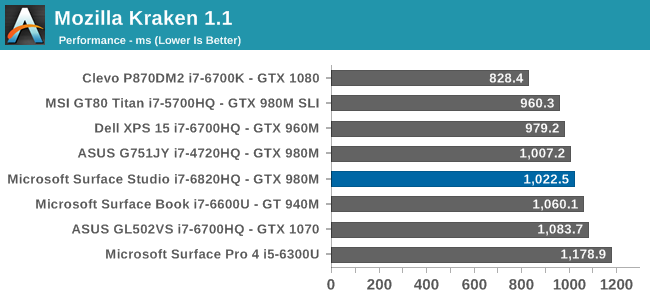
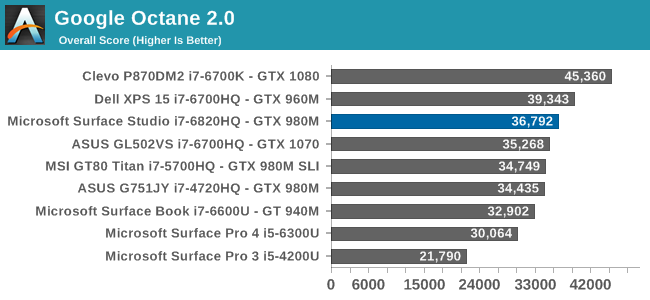

As with the other tests, the Surface Studio falls just a hair under the performance of typical quad-core laptops. With a sample size of one, it’s difficult to point the finger at why this is – is it cooling or is it something else – but I would have expected it to be just slightly ahead of the i7-6700HQ machines.










197 Comments
View All Comments
Manch - Monday, January 23, 2017 - link
I saw where you mentioned that the stress has to be supported at one end or another but its been proven that it can handle the stress just fine. As for the gap, while aesthetically unpleasing to some, or pleasing to others, I just don't see the big deal. Like others said, it ensures the keys don't contact the screen and unlike some laptops ahem Mac Book, key travel hasn't been sacrificed.BrokenCrayons - Tuesday, January 24, 2017 - link
I'd argue that it's been readily proven that the hinge design has been proven to fail under stress over time and there's little to no information available regarding the ability of the Surface Book to cope well with weight as a consequence to its design. However, there's a healthy dose of common sense that would make it pretty clear that half the plastic and metal would be less effective at supporting pressure from above or below than all of the plastic and metal.Key travel though, that's a point I agree with. Microsoft did manage to get that done in a manner of speaking, but it really didn't have to be that way to begin with if they'd bothered to add a largely unnoticable couple of millimeters of thickness. Instead, just like Apple and other companies, the Surface Book is chasing a pretty meaningless thickness measurement and surrendering functionality to do so. In the case of the Surface Book, that compromise is even more silly because the advantage of reduced thickness is ultimately still lost because there's a gap that ultimately makes the system thicker than it would have been had Microsoft recessed the keys and still maintained key travel distance.
jlabelle2 - Thursday, January 26, 2017 - link
- the hinge design has been proven to fail under stress over timeSo I am sure you have sources for that, do you?
- Instead, just like Apple and other companies, the Surface Book is chasing a pretty meaningless thickness measurement
They indeed made exactly the contrary. Instead of doing like Apple an put an almost no travel keyboard and standard hinge for specs bragging, they design a UNIQUE hinge that allow the screen to be further away when deployed for a better balancing and they put one of the maximum travel keyboard for comparably sized keyboard.
The hinge is not showing millimeters as you critizise but adds some at the gain of functionality.
nabnel - Friday, January 20, 2017 - link
Too many people comment and criticize the hinge design without actually understanding its function or why it's there. The hinge is designed to extend the effective base size when the laptop is opened, so that the weight distribution leaves it balanced and not top-heavy when used as a laptop. This is needed because the screen is heavier by a bit much than a typical laptop's screen. The other option wouldve to put more weight into the base, but that would increase the overall weight if the system.vLsL2VnDmWjoTByaVLxb - Friday, January 20, 2017 - link
The hinge design is criticized because it eventually results in a loose connection between the base and screen, the most important vital connection for a laptop. This results in keyboard drops, display resets, total machine crashes, and the inability to, you know, work on your $2000+ device. Having a Tablet isn't worth this instability.It's a design flaw. Every daily-used Surface Book will eventually see the hinge weaken and the above effects happen over and over again.
jlabelle2 - Monday, January 23, 2017 - link
- This results in keyboard drops, display resets, total machine crashesAny sources of that?
I have a Surface Pro 3 and having a removal keyboard never caused me the kind of issues you are claiming.
And having a separate tablet built-in in your laptop CERTAINLY worth it, I assure you.
- It's a design flaw.
The removal screen portion is a "design flaw"? You are kidding right?
BrokenCrayons - Monday, January 23, 2017 - link
"The removal screen portion is a "design flaw"? You are kidding right?"You're missing the context clues, I think intentionally, in order to suggest the idea of a removable screen/tablet is flawed in order to build a credible argument through suggesting that someone else is stating something stupid when that's not at all the case. Dockable tablets arent the problem. The hinge and connection, as already mentioned multiple times in this article's comments, is poorly engineered.
jlabelle2 - Thursday, January 26, 2017 - link
- The hinge and connection, as already mentioned multiple times in this article's comments, is poorly engineered.Which I think is an even more stupid comment. Look again the video of the hinge and compare to anything else on the market and you will realize that it is still unique and unrivalled design.
And anyone that own a Surface Book are praising the hinge, not the contrary.
BrokenCrayons - Thursday, January 26, 2017 - link
Unique doesn't automatically mean "better." I realize you want to defend this for psychological rather than practical reasons and that's completely okay. A handful of people can't help but fall in love with computers and honestly need to in order to justify why something is or isn't better than something else. Men in particular love comparing things and measuring differences in order to reach a conclusion that supports their underlying desires and will go as far as selecting other things that support their mental state. Say, comparing a Surface Book to a bottle of hand sanitizer and saying the Surface Book has better battery life and more storage space. I understand that it often can't be helped, but I encourage you to put human psychology under a critical microscope and attempt to transcend your biology during the process of thinking critically.Manch - Friday, January 27, 2017 - link
Please provide links for this massive hinge failure bc I cant find it.